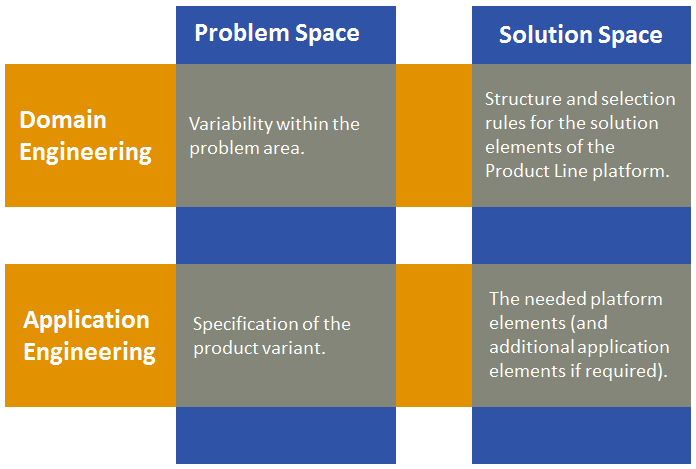However, before we introduce the example, we'll take a small detour into the basics of SPLE. The main difference from “normal”, one-of-a-kind software development, is a logical separation between the development of core, reusable software assets (the platform), and actual applications. During application development, platform software is selected and configured to meet the specific needs of the application.
The Product Line's commonalities and variabilities are described in the Problem Space. This reflects the desired range of applications (“product variants”) in the Product Line (the “domain”) and their inter-dependencies. So, when producing a product variant, the application developer uses the problem space definition to describe the desired combination of problem variabilities to implement the product variant.
An associated Solution Space describes the constituent assets of the Product Line (often referred to as the “platform”) and its relation to the problem space, i.e. rules for how elements of the platform are selected when certain values in the problem space are selected as part of a product variant. The four-part division resulting from the combination of the problem space and solution space with domain and application engineering is shown in Figure 3.1, “Overview of SPLE activities” . Several different options are available for modelling the information in these four quadrants. The problem space can be described e.g. with Feature Models, or with a Domain Specific Language (DSL). There are also a number of different options for modelling the solution space, for example component libraries, DSL compilers, generative programs and also configuration files.
In the rest of this chapter we will consider each of these quadrants in turn, beginning with Domain Engineering activities. We'll first look at modelling the problem space - what is common to, and what differs between, the different product variants. Then we'll consider one possible approach for realising product variants in the solution space using C++ as an example. Finally we'll look at how Application Engineering is performed by using the problem and solution space models to create a product variant. In reality, this linear flow is rarely found in practice. Product Lines usually evolve continuously, even after the first product variants have been defined and delivered to customers.
Our example Product Line will contain different products for entry and display of meteorological data on a PC. An initial brainstorming session has led to a set of possible differences (variation points) between possible products: meteorological data can come from different sensors attached to the PC, fetched from appropriate Internet services or generated directly by the product for demonstration and test purposes. Data can be output directly from the application, distributed as HTML or XML through an integrated Web server or regularly written to file on a fixed disk. The measurements to make can also vary: temperature, air pressure , wind velocity and humidity could all be of interest. Finally the units of measure could also vary (degrees Celsius vs. Fahrenheit, hPa vs. mmHg, m / s vs. Beaufort).
